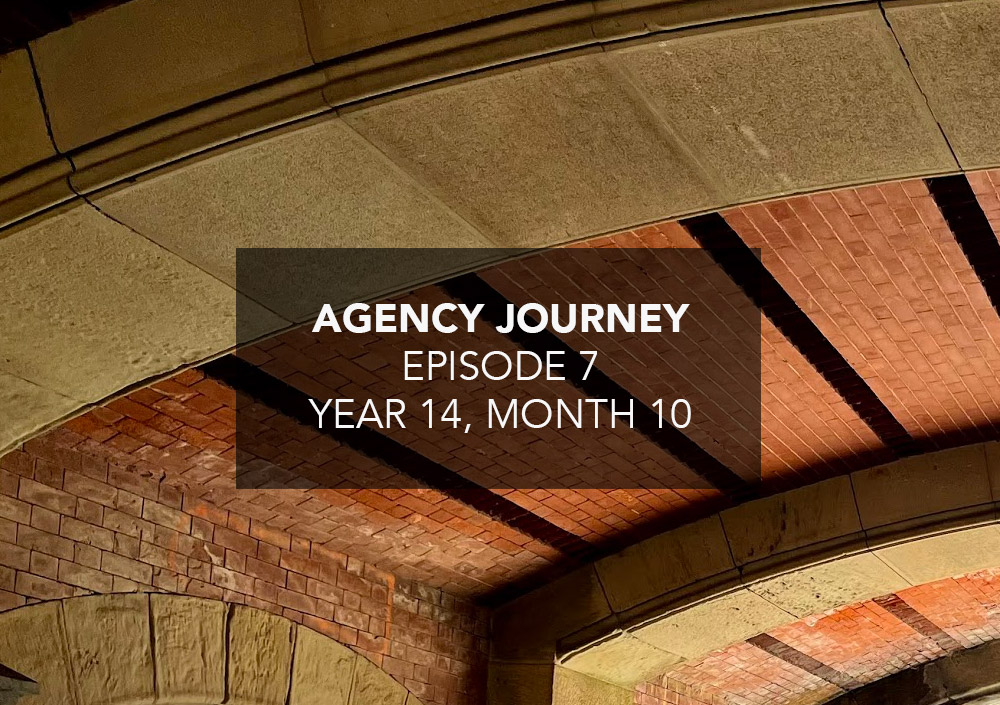It’s been over half a year since I started writing these and looking back on my previous posts, it’s incredibly humbling to see that the ideas I felt so sure and optimistic about at the time didn’t pan out the way I thought. Likewise, there are areas that I felt we had largely figured out or were trending in the right direction but in hindsight, it looks like we’re still trying to find our way.
I’m okay with this. If I’m continuing to learn and making progress as a business owner, my past decisions and perspectives should feel outdated and/or incomplete. What matters more, I believe, is that all these efforts trend in the right direction and are accretive in value to Barrel and to my own development as a leader.
That said, I’m excited to keep going with these and see what it feels like when, a year or two from now, I look back to see the progress that’s been made.
About Agency Journey: This is a monthly series detailing the happenings of my agency Barrel, founded in 2006. You can find previous episodes here.
Highlights
Leveling Up on HubSpot
As part of our overall push to automate more processes and upgrade our use of software across the agency, we made the move to upgrade our HubSpot CRM account from the free version to the Sales Hub Professional level, enabling features to do more on the app.
Our Director of Business Development Dan Fleishaker has been a driving force in making the most of the upgrade. He immediately made use of HubSpot’s proposals and contracts feature, creating templates and reusable snippets to drastically cut down the time it takes to create these docs. Best of all, instead of sitting separately in a manually created Dropbox account as Word docs and PDFs, these docs are all tied to the CRM deal record and reside centrally in the cloud.
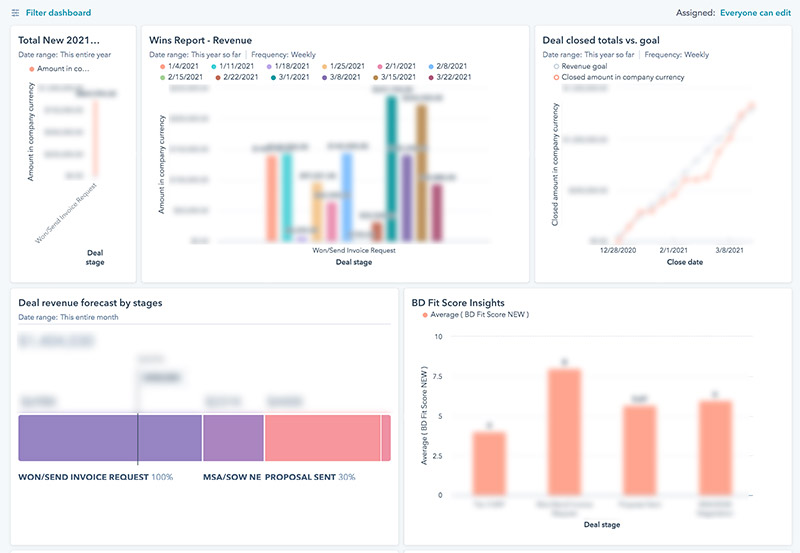
A partial screenshot of our Business Development Dashboard in HubSpot.
Among other changes brought out by this upgrade:
- Tighter integration between HubSpot and Slack, showing updates to deal status in our Business Development Channel.
- Our New Biz Matrix has been wholly integrated into HubSpot, so answering a few questions in the Deals record automatically scores the deal based on our criteria. No more manual Google Sheets and we can even run reports on trends of lead quality based on the scores over time.
- A fully customized dashboard showing how our business development efforts are trending as well as breakdown of lead sources.
- Automated invoicing notification trigger when deals are signed and marked as “Invoiced” – an automatic email with the relevant information and signed SOW is sent to our finance team to process the invoice.
This has all happened in just the past few weeks. The velocity at which Dan has been experimenting and rolling out new use cases has been incredible. It’s another reminder that good things happen when I can get out of the way and let talented and capable people do their thing.
We’re excited to see how we can further leverage HubSpot’s features to automate and scale our various sales and marketing efforts. Things like onboarding email workflows for new clients and deeper integration with our other tools like Asana are under consideration as well as a dozen other ideas that will pop up as we keep playing around.
Agency One-Pager
We put together an agency one-pager PDF file that we could share with prospective referrers. These are folks who may invest in or sell to businesses that are ideal client targets for us. The referrers tend to be investors (venture capital or private equity in consumer goods), founders who’re helping other founders, marketing consultants working with various brands, other agencies doing different types or scale of work than us, or software companies whose customer base overlap with us (e.g. Shopify and companies in the app ecosystem).
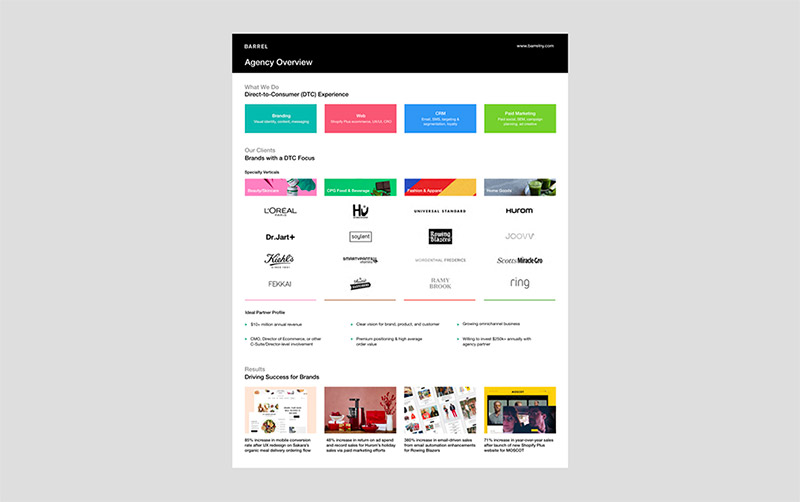
A screenshot of our agency one-pager PDF. It took several iterations for us to feel good about the flow and order of the content.
I found the exercise of putting together the one-pager very helpful because it forced us to really think hard about our positioning. Rather than fully capture the broad range of clients we serve today, we focused on the roster we wanted to continue to develop: brands with a certain level of scale ($10 million+ annual revenue) with a great deal of investment in the direct-to-consumer (DTC) experience. And within this segment, we specified four verticals where we felt strongest based on our case studies and expertise: beauty, consumer packaged goods (specifically food & beverage), fashion & apparel, and home goods.
And speaking of expertise, the one-pager leads with four very clear buckets of service offerings: Branding, Web, CRM, and Paid Marketing. It was helpful to hone in our of services this way, to keep it as simple and easy to articulate as possible.
We’ve been sharing the one-pager proactively and making slight tweaks based on feedback. It was also helpful to share it with the entire team, and it’s something that we’ll have to make a part of our recruitment and onboarding process as well.
Novus Global Training
In early March, we began our engagement with Novus Global, an executive coaching firm, by going through their team onboarding experience. Our 6-month coaching contract is for 10 people but Novus require a team-wide training to help everyone get the most of the engagement.
Conducted over the course of 4 days and split into two 90-minute sessions per day, the training was a big time investment for our team, requiring a bit of scheduling jiu jitsu to ensure 35+ team members across various time zones could attend 100% of the sessions.
To add to the scheduling challenges, my wife Melanie and I welcomed our son Teddy after Day 1 of training. I wasn’t sure I could attend the remaining sessions. Luckily, Mel was very understanding and our setup at the hospital (high speed WiFi and a private room) allowed me to participate and not miss much.
From what I can see, I think certain members of our team found the training very engaging and perhaps even life-changing. Others were somewhat skeptical but tolerated the mandatory sessions. And a small number were very skeptical and didn’t see the point of the training at all.
I personally enjoyed the sessions and appreciated the concepts that were introduced. The Novus team used a great analogy of comparing these concepts/tools to equipment in a gym and the active use of these tools to lifting or exercising. This resonated deeply with me because I’ve seen the impact when you learn how to do certain exercises (e.g. deadlifts, squats, bench, etc.) and put in the time to execute the reps regularly.
Here were some of the “equipment” I found compelling and hope to “lift” regularly:
- Disempowered vs. Empowered Language: detecting, observing, and tweaking the ways we use language, since how things occur to us is rooted in language (e.g. “I can’t”/”I wasn’t allowed to”/”It didn’t seem possible” vs. “I will”/”I intend to”/”I believe”)
- Giving & Receiving Feedback: a structured framework to do this well; I especially liked the act of “focusing on the 1% that’s true” when receiving feedback
- Break Your Brain: giving the brain a problem worth solving that goes outside its “intuitive fence” and pushes the individual beyond what they thought was even possible
- Funnel of Specificity: pushing ourselves to go beyond vague goals (“We want a better culture”) and being specific about the desired outcomes (see my blog post “Turning Vague Goals into Specific Goals at Your Agency” which was inspired by this tool)
Top of Mind
Busting Through the Intuitive Fence
The Novus Global training and my prep for upcoming coaching sessions got me thinking about our vision for Barrel and how we’ve shied away from explicit long-term goals, especially around financial performance. I think part of this comes from years of being in survival mode, where just getting through the year felt like a miracle, so to think beyond the next year seemed presumptuous.
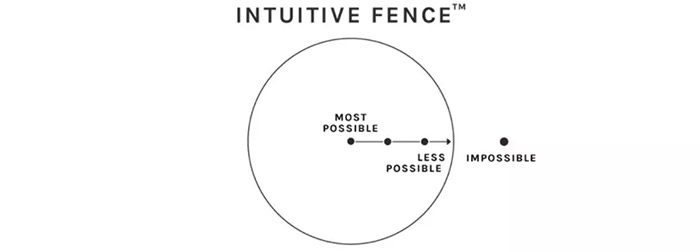
Intuitive Fence™ diagram taken from Novus Global’s website.
The Intuitive Fence™ (it’s Novus’s trademarked term – read this blog post for more details) for us has been our “realistic” view that we can only grow incrementally and must struggle one year at a time to hopefully squeeze past the prior year’s result. The problem with this mindset is that it devotes our brainpower to solving for incremental performance vs. trying new approaches to break through and drive exponential growth.
The more I reflect on this, I think it boils down to A) setting a vision that, in the moment, feels out of our grasp and B) committing ourselves to making the necessary moves to do things differently than what we’re doing now.
We’ve been working on a vision that aligns on a revenue and profit goal for 2025. We’re going to invest the time and effort to reconfigure the business so we can get there. Given where we are today, the word “impossible” comes to mind, but there’s also a part of me that really believes we’ll get there.
Systematizing Lead Generation
I’ve been obsessed with The Millionaire Real Estate Agent by Gary Keller. While written for real estate agents, the book has amazing value for anyone running a business. The way it breaks down the “Big Models” that go into a well-functioning business is just incredible. You can check out some of the highlights I’ve compiled in my Twitter thread about the book.
The lessons I want to apply right away to Barrel are around lead generation. Keller shows how you can work backwards from your desired net income and see exactly how many leads you need to generate to get there. This type of modeling is nothing new and it’s something I’ve done dozens of times for clients in the past when modeling out their digital marketing spend, but I realized I never did this in-depth for Barrel. It’s only been a little over a year since we tracked our lead volume and win conversion rates, so we are really ripe for comprehensive modeling and systemization of our lead generation process.
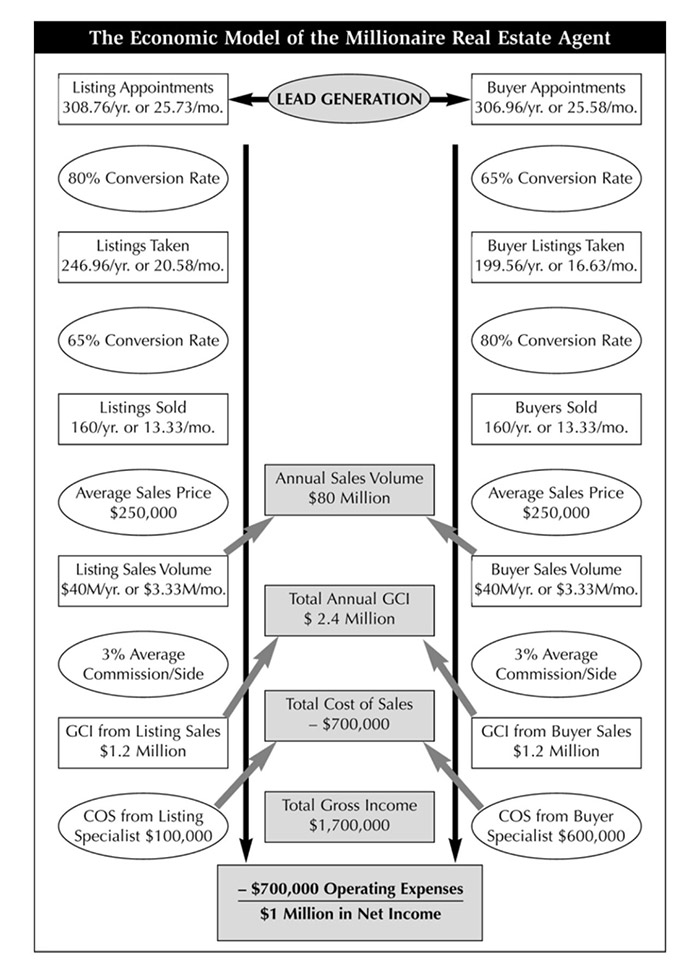
From The Millionaire Real Estate Agent by Gary Keller. The Economic Model is one of numerous “Big Models” in the book that help break down the fundamentals of the business.
The two areas that I see great opportunity for us right away are:
- Marketing: all the activities that will raise our awareness and get us in front of prospective clients or referrers in a consistent and automated way through output of compelling content and easy-to-remember messaging delivered in the right contexts (will blog about this separately in depth once we get things going)
- Referral Network: taking care of all of our potential referrers starting first with our existing clients and those who can really vouch for our work; we’ve not been consistent in our efforts here, so we can really plug in some gaps and nurture relationships with folks who’re eager to send us work
What fits nicely with the lead generation efforts is making even greater use of our CRM. That we’ve made the upgrades to our HubSpot usage comes at a good time. I think we’ll lean into it even more heavily in the coming months and potentially unlock their marketing automation functions as well.
Shared with Partners
“Often the only way to make a hard decision is to come back to the purpose of what you’re doing.” (David Allen, Getting Things Done)
Sometimes, I feel like we’re faced with challenging decisions on a daily basis. It’s easy to act on fear especially of short-term consequences, but these may be at odds with where we want to be in the long run. This is why having a long-term vision coupled with a clear mission can be critical anchors when faced with tough decisions ranging from new business opportunities, how to handle client mess-ups, or personnel-related situations.
“The unsaid but communicated includes (but is not limited to) assumptions, expectations, disappointments, resentments, regrets, interpretations, significance, and issues that occur as dangerous.” (Steve Zaffron and Dave Logan, The Three Laws of Performance)
Coming out of the Novus Global training, I was emboldened to express to my co-founder Sei-Wook some of my disappointments and resentments that I harbored against him. It wasn’t anything wrong he was doing but just how I perceived his actions and communication style and how I built up a narrative in my mind that trended towards a negative place. We spoke for nearly 3 hours and cleared the air. It was much needed and the “unsaid” was brought to light for us to observe and ultimately set off into the past as we look ahead.
“Some things are better off ignored than attacked. Attention is the oxygen of conflict. When you fight a problem, you breathe life into it. When you starve a problem of your attention, you suffocate it. In a surprising number of cases, the way to solve a problem is to ignore it.” (James Clear, 3-2-1 Newsletter)
During my parental leave, I found myself in a situation where I involved myself in talking to an employee about their discontentment about certain things. This eventually blew up into several back-and-forth emails that ate up hours of my time, stressing me out and monopolizing my attention at a time when I should’ve been focused on my newborn. This was my bad and something easily preventable by not breathing attention into it in the first place.
“Countless business owners complain about their lack of control or freedom and yet, in the same breath, discount the value of process. It’s like the story of the dog sitting on a nail. A gentleman walks up to a farmhouse. On the porch is an old man sitting in his rocking chair, and next to him is his old dog. The old dog is moaning, so the gentleman asks the old man why. ‘It’s because he’s sitting on a nail,’ the old man replies. ‘Why doesn’t he move?’ asks the gentleman. ‘Because it’s not hurting enough for him to move.'” (Gino Wickman, Traction)
I don’t love the phrase “if it ain’t broke, don’t fix it ” because it’s the same sentiment as the quote above–the status quo is good enough. Breaking through the Intuitive Fence™ and setting sights on the impossible is a great way to overcome the inertia. In order to grow exponentially, even the things that are “working okay” need to be reviewed and potentially blown up to make way for something new.
“A company that thinks like a small company remains small. A company, even a one-person army, that thinks and acts like a big company is going to grow faster, smarter, and better.” (Chet Holmes, The Ultimate Sales Machine)
One of the things I realized while reading The Millionaire Real Estate Agent was that we had indeed failed to think like a bigger company, always keeping our sights on preserving where we were instead of where we could be. While obvious in hindsight, I’m eager for us to reorient and start designing Barrel for what it could be like at 5-10x our current revenues.
